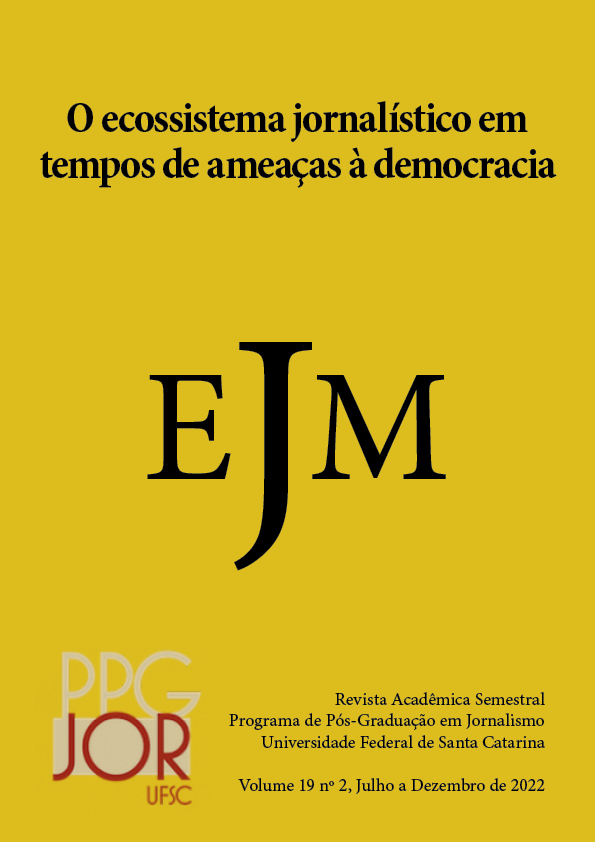Os impactos da desinformação sobre a Covid-19 no telejornalismo paraibano
DOI:
https://doi.org/10.5007/1984-6924.2022.89662Palavras-chave:
Telejornalismo, Rotinas produtivas, DesinformaçãoResumo
Este artigo tem como objetivo buscar entender como a desinformação existente no contexto pandêmico vem afetando as rotinas produtivas dos jornalistas da TV Paraíba - afiliada da Rede Globo em Campina Grande/PB. Trazemos estudos essenciais a respeito da desinformação (WARDLE, 2017) e pós-verdade (D’Ancona, 2018), além de tomarmos como norte estudiosos como Wolf (1999) e Vizeu (1999), dentre outros. A pesquisa tem como base metodológica o Estudo de Caso, por meio da realização de entrevistas semiestruturadas com uma abordagem qualitativa. Constatou-se que, no recorte adotado neste trabalho, o nível de tensão entre os jornalistas cresceu diante da responsabilidade e necessidade de uma apuração dos fatos ainda mais cautelosa em um tempo ainda mais restrito frente à urgência e perecividade dos dados relacionados à pandemia. Além disso, constatou-se que o profissional jornalista fortalece sua função pedagógica perante à população, uma vez que estes profissionais são um dos responsáveis por desmentir as informações enganosas que estão circulando na sociedade.
Referências
ABRAJI. Pesquisas alertam para agravamento do estresse emocional de jornalistas brasileiros. 2020. Disponível em: https://abraji.org.br/noticias/pesquisas-alertam-para- agravamento-do-estresse-emocional-de-jornalistas-brasileiros. Acesso em 04 de julho de 2021.
ADORNO, T. W. “A Indústria Cultural” e "Televisão, Consciência e Indústria Cultural. In: Cohn, Gabriel (org.). Comunicação e Indústria Cultural, São Paulo, Ed. Nacional, 1975.
ALLCOTT, Hunt; GENTZKOW, Matthew. Social Media and Fake News in the 2016 Election. Journal of Economic Perspectives. p. 211-36, 2017. Disponível em: https://web.stanford.edu/~gentzkow/research/fakenews.pdf. Acesso em 16 de julho de 2021.
AVAAZ. (04 de maio de 2020). O Brasil está sofrendo uma infodemia de Covid-19. Disponível em: https://secure.avaaz.org/campaign/po/brasil_infodemia_coronavirus/. Acesso em 18 de julho de 2021.
CASTILHO, F; FIALHO, F. O jornalismo ingressa na era da produção colaborativa de notícias. In RODRIGUES, Carla. Jornalismo Online: Modos de Fazer. Rio de Janeiro: Ed. PUC-Rio e Editora Sulina, 2009. 119 p. - 146 p.
DARNTON, Robert. A verdadeira história das notícias falsas. 2017. El País, 30 de abril de 2017. Disponível em: https://brasil.elpais.com/brasil/2017/04/28/cultura/1493389536_863123.html. Acesso em 16 de julho de 2021.
FANTIN, M. (2011). Mídia-educacão: aspectos históricos e teórico-metodológicos. Olhar de Professor, Ponta Grossa, 14 (1), pp. 27-40. Disponível em: https:// www.revistas2.uepg.br/index.php/olhardeprofessor/article/view/3483/2501. Acesso em 19 de julho de 2021.
FERRARETO, Luiz Artur; MORGADO, Fernando. Covid-19 e comunicação: um guia prático para enfrentar a crise. Rio Grande do Sul: UFRGS, 2020.
GIL, Antônio Carlos. Métodos e técnicas de pesquisa social. Editora Atlas, São Paulo, 6ª ed., 2008.
JORGE, Thaís de Mendonça. NOTÍCIA e FAKE NEWS: uma reflexão sobre dois aspectos do mesmo fenômeno da mutação, aplicada ao jornalismo contemporâneo. Revista Âncora, João Pessoa, v. 4, n. 2, p. 57-73, jul/dez 2017.
MESQUITA, G.B. Intervenho, logo existo: a audiência potente e as novas relações no jornalismo. Tese (Doutorado em Comunicação). Programa de Pós-Graduação em Comunicação. Universidade Federal de Pernambuco - UFPE, Recife, 2014.
Organização Pan-Americana da Saúde. Entendendo a infodemia e a desinformação na luta contra a COVID-19 [Internet]. Folheto informativo. Saúde digital. Washington, D.C.; 2020.Disponível em: https://iris.paho.org/bitstream/handle/10665.2/52054/Factsheet-Infodemic_por.pdf?sequence=14. Acesso em 18 de julho de 2021.
OXFORD DICTIONARIES. Oxford dictionaries word of the year 2016. Londres, 2016. Disponível em: https://languages.oup.com/word-of-the-year/word-of-the-year-2016. Acesso em 19 de julho de 2021.
P Sánchez-Garcia, E Campos-Domínguez, S Berrocal Gonzalo (2015): As funções inalteráveis do jornalista diante dos perfis emergentes de multimídia. Revista Latina de Comunicação Social, 70, pp.187 a 208. Disponível em: https://www.researchgate.net/publication/283270899_Las_funciones_inalterables_del_periodista_ante_los_perfiles_multimedia_emergentes. Acesso em 24 de julho de 2021.
PATRÍCIO, E. Jornalismo e pandemia: impactos da covid-19 nas rotinas de produção do jornalismo independente do ceará. Pauta Geral - Estudos em Jornalismo, [S.L.], v. 7, p. 1-18, 2020. Universidade Estadual de Ponta Grossa (UEPG). http://dx.doi.org/10.5212/revistapautageral.v.7.17060.290. Disponível em: https://revistas2.uepg.br/index.php/pauta/article/view/17060. Acesso em 24 de julho de 2021.
PAVLIK, John. Journalism and new media. Columbia University Press: New York, 2011.
Reuters Institute. 2021. Digital News Report 2021. (online). Disponível em: https://static.poder360.com.br/2021/06/Digital-News-Report-2021.pdf. Acesso em 20 de julho de 2021.
RHODE, André. Jornalismo e pandemia na TV. In: EMERIM, Cárrlida. A (re)invenção do Telejornalismo em tempos de pandemia. Florianópolis: Insular, 2020. p. 1-312.
SILVA, L. J. C. da. Saberes, linguagem e dispositivos didáticos: as dimensões da função pedagógica do telejornalismo / Laerte José Cerqueira da Silva. – Recife, 2018.
UNESCO (2018). A Global Framework of Reference on Digital Literacy Skills for Indicator 4.4.2. UNESCO Institute for Statistics. Montreal, Canadá. Disponível em: http://uis.unesco.org/sites/default/files/documents/ip51-global-framework-reference-digital-literacy-skills-2018-en.pdf Acesso em 19 de julho de 2021.
VIZEU, A.; CORREIA, J. C. A construção do real no telejornalismo: do lugar de segurança ao lugar de referência. In: VIZEU, A. A sociedade do telejornalismo. Petrópolis: Vozes, 2007.
VIZEU, A; LEITE, F. DECIDINDO O QUE É NOTÍCIA: 20 anos depois. Revista Observatório, [S.L.], v. 4, n. 4, p. 284-307, 29 jun. 2018. Universidade Federal do Tocantins. http://dx.doi.org/10.20873/uft.2447-4266.2018v4n4p284.
WARDLE, Claire; DERAKHSHAN, Hossein. Information disorder: Toward an interdisciplinary framework for research and policymaking. Strasbourg: Council of Europe, 2017. Disponível em: https://rm.coe.int/information-disorder-toward-an-interdisciplinary-framework-for-researc/168076277c. Acesso em 16 de julho de 2021.
WOLF, Mauro. Teorias da comunicação. Lisboa: Presença, 1999.
YIN, Robert K. Estudo de caso: planejamento e métodos. 3 ed. Porto Alegre: Bookman, 2005.
Downloads
Publicado
Edição
Seção
Licença
Ao encaminhar textos à revista Estudos em Jornalismo e Mídia, o autor estará cedendo integralmente seus direitos patrimoniais da obra à publicação, permanecendo detentor de seus direitos morais (autoria e identificação na obra), conforme estabelece a legislação específica. O trabalho publicado é considerado colaboração e, portanto, o autor não receberá qualquer remuneração para tal, bem como nada lhe será cobrado em troca para a publicação. As ideias e opiniões expressas no artigo são de exclusiva responsabilidade do autor, não refletindo, necessariamente, as opiniões da revista. Citações e transcrições são permitidas mediante menção às fontes. A revista Estudos em Jornalismo e Mídia está sob a Licença Creative Commons



